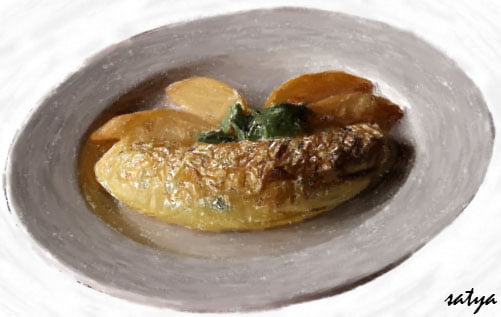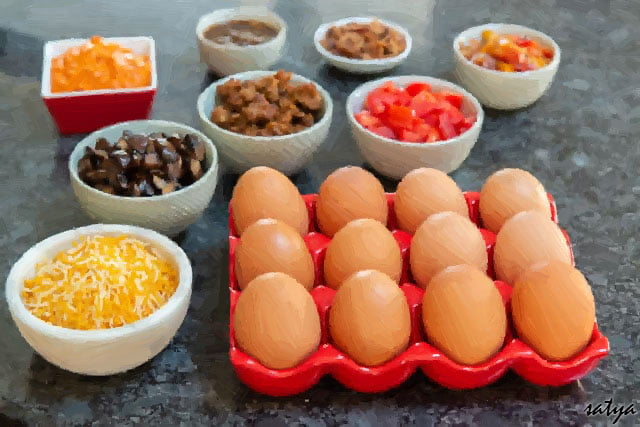The Perfect Omelette: Sounds So Simple, But Difficult To Master

The omelette, which requires a delicate touch, a precise sense of timing and an almost intuitive feel for the egg (one of the most finicky but essential staples of cooking), is something many chefs consider a milestone in their culinary journey. It’s simple to make, but difficult to master.
I remember struggling and burning a lot of eggs, a lot of omelettes right off the bat. You just had to move really fast. I would always turn the egg pan up too hot, but my dad would be like, ‘No, no, it has to go lower.’
Eventually the omelettes did come out right, not charred. A perfect omelette is one which is cooked all the way through — not runny in the middle, not scorched on the outside.
Initially I was obsessed with the perfect omelette according to the French — softly scrambled, no colour, perfectly barely set eggs, oozing with a fine cheese. Growing up, we saw that omelette was made in a cast-iron pan — they were cooked pretty hard and always had crispy edges.
The best I liked was on the method of Vietnamese ‘banh xeo’, the original recipe which did not have eggs. I make it with egg in the batter, and instead of the usual shrimp and sprouts filling, I use cheese, sprouts and pork.
I cook the egg with corn starch and turmeric batter really hard in a wok. When it starts to get crispy, I fill in the cheese, crispy chicken, sprouts and herbs, fold it over and press against the heat to crisp further. I eat it with lettuce wraps or blanched pumpkin leaves. That’s my idea of the perfect omelette, something crispy and fresh, but still luscious with cheese.

Omelettes are a permanent fixture on the English menu.
To try an English omelette, start with a lovely, hot, seasoned cast-iron pan (that would never be washed, just cleaned) with a touch of butter just lightly frothed. Add the beaten eggs and sprinkled fine herbs and salt into the pan. Keep the pan on medium heat and flip the omelette so that each layer at the bottom would fold over onto the top (with a push-and-pull-back motion) that would result in lovely ribbons of perfectly cooked egg.
The omelette will be perfect by the smell of the egg and the way it slipped down the pan for the fold. If it is stuck on the way down, it won’t be smooth and instead there will be a crease.
At the end of the process, you will have to tilt the pan up so that you can achieve the desired shape for the omelette by knocking edge of the pan. This action will create a nice, tight pointed-edge (that is, oval) shape. Then, you grab a plate and place the pan at an angle to turn out the omelette. When you eat the omelette, there is a sense of satisfaction from creating those perfect ribbons.
The American omelette, on the other hand, is two-fold, unlike three-fold French omelette. The ridges are always smooth. Take a fork, curved-side down, keeping the bottom of the fork in a circular motion while shaking the pan back and forth, breaking up the egg in the middle and cooking it right there. That fork thing is important to get a completely smooth omelette.
Yet, today very few can make a perfect omelette which is perfectly cooked and perfectly shaped. To me, an omelette has to melt in the mouth. You’d think that the simplest things are always the easiest things to make, but quite the contrary. It’s obvious you have to start with great-quality eggs raised by cage-free chickens, and you know when they’re perfect because the yolks are almost orange, not pale yellow.
Let’s not fool ourselves, the perfect omelette doesn’t exist. It has not yet been made. There are unbelievable omelettes; good, excellent and even astonishing omelettes. But there is no such thing as the perfect omelette. With just butter or oil, two eggs and salt as your only ingredients, nothing is more basic. But that is precisely what makes this dish so difficult. It is the perfect challenge for any chef.
To make the best possible omelette, it’s about you and your eggs becoming one. You have to feel the egg in order to know exactly when it is ready. A recipe you can give away, but that feeling you cannot teach. It’s not an easy task.
You have to be gentle with the pan, control the temperature, avoid stirring too much or too little, and make sure you have just enough oil or butter. To achieve a finished omelette with a crepe-like texture on the outside and a moist and almost runny inside, it all starts with finding the best-quality egg.
I can’t remember the exact day I made an omelette right, but I remember doing one after another and getting frustrated. An omelette is quite magical. The process of making an omelette taught me that cooking really takes finesse, skill and coordination.

Comments are closed.